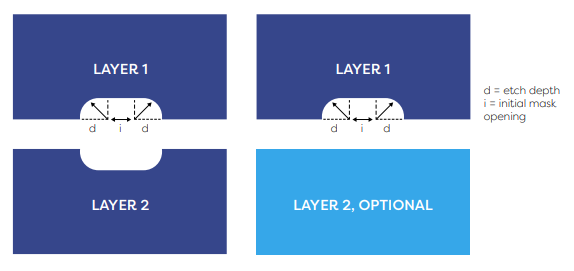shopping_basket
Wet Etching
What is wet etching?
Photolithographic techniques can be used to locally protect a glass wafer surface before exposing it to hydrofluoric acid (HF). When exposed to HF, the remaining glass parts will be removed. Both the depth and width of the channel will grow until the target depth is reached and the wafer is removed from the HF bath. Subsequently, the layer can be (fusion) bonded with an additional layer to create sealed chips.
Which materials?
- Borosilicate glass: D263, D263-bio, BF33, MEMPAX
- Fused Silica
Why wet etching of glass?
- Glass is the material with the best optical properties available.
- Glass is highly chemically and temperature resistant.
- Extremely smooth surface: roughness is in angstrom range
- Fully transparent surfaces
- Highly accurate structures, accuracy on the etch depth is ~5%. (default: ~10%).
The initial masker opening is lithographical defined and such extremely accurate. - Possibilities to produce ultra-flat products exists, glass has by default good shape stability and is relatively flat.
- Several wafers can be etched in a single etching step.
What should you know?
During etching, glass will be removed in all direction with the same speed, not only the depth of unprotected surfaces will increas but also the width.
This creates the following relationship between channel width and depth:
{channel width} = 2 * {etch depth} + {initial mask opening}
The required minimal initial mask opening depends on the desired etch depth:
| Desired depth [µm] | Minimal initial mask opening [µm] |
| <6 | 5 |
| 6-20 | 5 |
| 20-50 | 10 |
| 50-250 *) | 50 |
*) Etch rates in fused silica is very low, for that reason the etch dpeth is limited ~50µm.
Shape example - single depth etching
Shape example - double depth etching
What is wet etching?
Photolithographic techniques can be used to locally protect a glass wafer surface before exposing it to hydrofluoric acid (HF). When exposed to HF, the remaining glass parts will be removed. Both the depth and width of the channel will grow until the target depth is reached and the wafer is removed from the HF bath or the spray etch process is stopped. Subsequently, the layer can be (fusion) bonded with an additional layer to create sealed chips.
Which materials?
-
Borosilicate glass: D263, D263-bio, BF33, MEMPAX
-
Fused Silica
Why wet etching of glass?
-
Glass is the material with the best optical properties available.
-
Glass is highly chemically and temperature resistant.
-
Extremely smooth surface: roughness is in angstrom range
-
Fully transparent surfaces
-
Highly accurate structures, accuracy on the etch depth is ≤5%. (smaller as 5µm is often feasible).
The initial masker opening is lithographical defined and such extremely accurate.
-
Possibilities to produce ultra-flat products exists, glass has by default good shape stability and is relatively flat.
-
Several wafers can be etched in a single etching step.
What should you know?
During etching, glass will be removed in all direction with the same speed, not only the depth of unprotected surfaces will increas but also the width.
This creates the following relationship between channel width and depth:
{channel width} = 2 * {etch depth} + {initial mask opening}
The required minimal initial mask opening depends on the desired etch depth:
| Desired depth [µm] | Minimal initial mask opening [µm] |
| <6 | 5 |
| 6-20 | 5 |
| 20-50 | 10 |
| 50-250 *) | 50 |
*) Etch rates in fused silica is very low, for that reason the etch dpeth is limited ~50µm.
Shape example - single depth etching
Shape example - double depth etching



